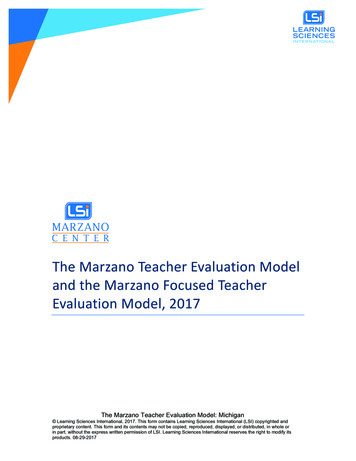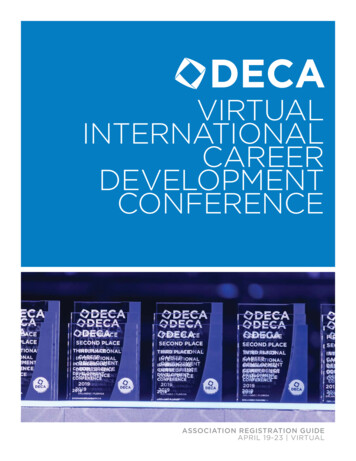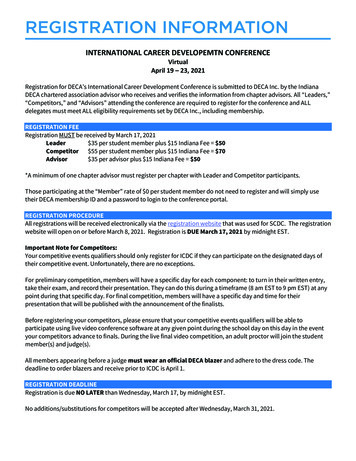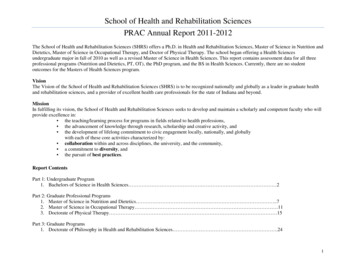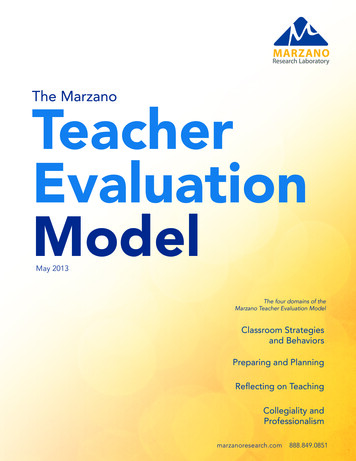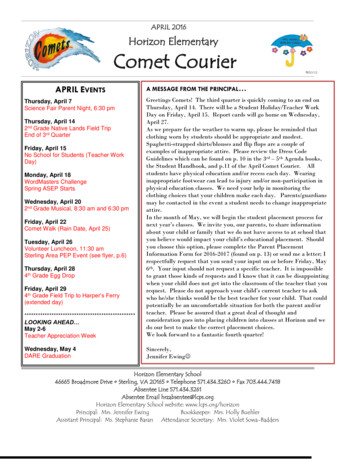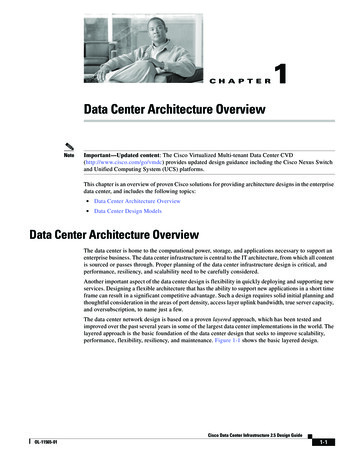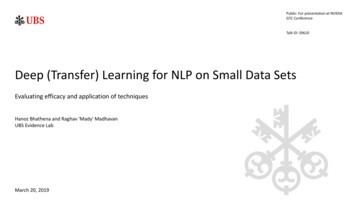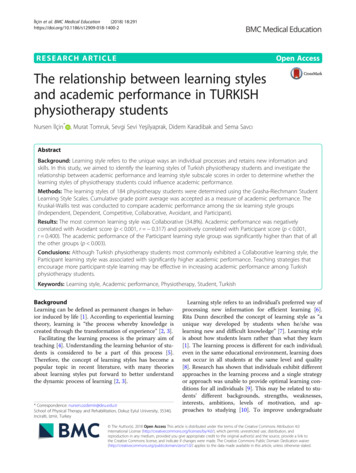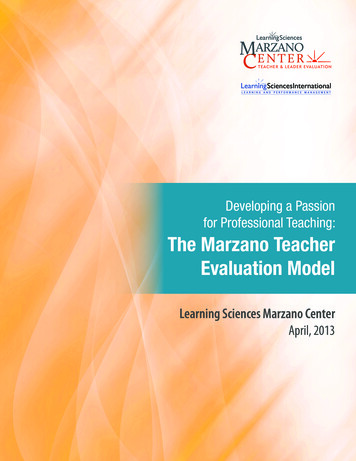
Transcription
TEACHER & LEADER EVALUATIONDeveloping a Passionfor Professional Teaching:The Marzano TeacherEvaluation ModelLearning Sciences Marzano CenterApril, 2013
OUR MISSIONLearning Sciences Marzano Center promotes excellence in publiceducation by providing and developing next-generation teacher andleadership evaluation tools and training. Built on a foundation of expertresearch into best practices under the direction of national researcherand author Dr. Robert Marzano, and staffed by a team of educationexperts, the Marzano Center identifies, develops, and disseminatescutting-edge resources in educational best practices. Our goal is tosupport teachers to be highly effective, lifelong learners, and in doingso, to significantly impact student growth and achievement over time.TEACHER & LEADER EVALUATION1.877.411.7114MarzanoCenter.com 2013 Learning Sciences International
TEACHER & LEADER EVALUATIONINTRODUCTIONTeaching is an enormously complex task. The skilled teacher uses anartful combination of practical experience, judgment, passion, teachingstrategies, and the responsiveness to differing student learning needs.Even more, any committed teacher can become a better teacher overtime with focused practice in research-based strategies.One way that even experienced teachers can improve their instructionin the Marzano Teacher Evaluation Model is based on an extensivereview of the literature; it is the only evaluation model to have beentested by action research studies in the field. No other model has beensubjected to such a wide array of experimental/control and correlationstudies. On average, as teachers improved at using the classroomstrategies and behaviors in the Marzano Teacher Evaluation Model,typical student achievement increased by 16 percentile points.Further, the model works in any professional development situation:self-development, peer-to-peer development, and whole-schooldevelopment. In this brief paper, we’ll offer a big-picture understandingof the model design, with a focus on Lesson Segment 2, AddressingContent. Teachers may work independently or with their colleagues orPLCs to grow their classroom expertise through deliberate practice ofthe model’s strategies.USING THE MARZANO MODELFOR PROFESSIONAL GROWTHThe four domains of the Marzano Teacher Evaluation Modelcontain 60 elements, each of which builds on the others to supportteacher growth, development, and performance. (See Figure 1). Domain 1 – Classroom Strategies and BehaviorsDomain 2 – Planning and PreparingDomain 3 – Reflecting on TeachingDomain 4 – Collegiality and ProfessionalismUnlike other evaluation models, the Marzano Teacher EvaluationModel shines the spotlight on Domain 1: Classroom Strategiesand Behaviors. This domain contains not only the largest number ofstrategies, but also those that have been shown in causal studies tohave the most direct effect on improving student performance.Together, the four domains contain 60 elements thatdefine a knowledge base for teaching and a frameworkfor the systematic development of expertise.Developing a Passion for Professional Teaching: The Marzano Teacher Evaluation ModelPAGE 3
Figure 1 - Four Domains of the Marzano Teacher Evaluation ModelDeveloping a Passion for Professional Teaching: The Marzano Teacher Evaluation ModelTEACHER & LEADER EVALUATIONPAGE 4
Domain 1: Classroom Strategies and BehaviorsDomain 1 is based on the Art and Science of Teaching Framework and identifies the 41 elements or instructionalcategories that happen in the classroom. The 41 instructional categories are organized into 9 Design Questions (DQs)and further grouped into 3 Lesson Segments to define the Observation and Feedback Protocol.Lesson SegmentInvolving Routine EventsDQ1: CommunicatingLearning Goals and Feedback1. Providing Clear Learning Goalsand Scales (Rubrics)2. Tracking Student Progress3. Celebrating SuccessDQ6: Establishing Rulesand Procedures4. Establishing Classroom Routines5. Organizing the Physical Layout ofthe ClassroomNote: DQ refers to Design Question inthe Marzano Art and Science of TeachingFramework. The nine (9) DQs organizethe 41 elements in Domain 1.Lesson SegmentAddressing ContentLesson SegmentEnacted on the SpotDQ2: Helping Students Interact withNew Knowledge6. Identifying Critical Information7. O rganizing Students to Interact with NewKnowledge8. Previewing New Content9. C hunking Content into “Digestible Bites”10. Processing of New Information11. Elaborating on New Information12. Recording and Representing Knowledge13. Reflecting on LearningDQ5: Engaging Students24. Noticing When Students are Not Engaged25. Using Academic Games26. Managing Response Rates27. Using Physical Movement28. Maintaining a Lively Pace29. Demonstrating Intensity and Enthusiasm30. Using Friendly Controversy31. Providing Opportunities for Students to Talkabout Themselves32. Presenting Unusual or Intriguing InformationDQ3: Helping Students Practice and DeepenNew Knowledge14. Reviewing Content15. O rganizing Students to Practice andDeepen Knowledge16. Using Homework17. Examining Similarities and Differences18. Examining Errors in Reasoning19. P racticing Skills, Strategies, andProcesses20. Revising KnowledgeDQ7: Recognizing Adherence to Rules and Procedures33. Demonstrating “Withitness”34. Applying Consequences for Lack of Adherence to Rulesand Procedures35. Acknowledging Adherence to Rules and ProceduresDQ4: Helping Students Generate andTest Hypotheses21. O rganizing Students for CognitivelyComplex Tasks22. E ngaging Students in Cognitively ComplexTasks Involving Hypothesis Generationand Testing23. Providing Resources and GuidanceDomain 2: Planning and PreparingPlanning and PreparingPlanning and Preparing for Lessonsand Units42. Effective Scaffolding of Informationwithin Lessons43. Lessons within Units44. Attention to Established ContentStandardsPlanning and Preparing for Useof Resources and Technology45. Use of Available Traditional Resources46. Use of Available TechnologyPlanning and Preparing for the Needs ofEnglish Language Learners47. Needs of English Language LearnersPlanning and Preparing for the Needs ofStudents Receiving Special Education48. Needs of Students ReceivingSpecial EducationPlanning and Preparing for the Needs ofStudents Who Lack Support for Schooling49. Needs of Students Who LackSupport for SchoolingTEACHER & LEADER EVALUATIONDomain 3: Reflecting on TeachingReflecting on TeachingEvaluating Personal Performance50. Identifying Areas of PedagogicalStrength and Weakness51. Evaluating the Effectiveness ofIndividual Lessons and Units52. Evaluating the Effectiveness ofSpecific Pedagogical Strategiesand BehaviorsDeveloping and Implementinga Professional Growth Plan53. Developing a Written Growthand Development Plan54. Monitoring Progress Relative tothe Professional Growth andDevelopment PlanDQ8: Establishing and Maintaining EffectiveRelationships with Students36. Understanding Students’ Interests and Background37. Using Verbal and Nonverbal Behaviors that IndicateAffection for Students38. Displaying Objectivity and ControlDQ9: Communicating High Expectations for All Students39. Demonstrating Value and Respect for LowExpectancy Students40. Asking Questions of Low Expectancy Students41. Probing Incorrect Answers with Low ExpectancyStudentsDomain 4: Collegiality and ProfessionalismCollegiality and ProfessionalismPromoting a Positive Environment55. Promoting Positive Interactions with Colleagues56. Promoting Positive Interactions about Studentsand ParentsPromoting Exchange of Ideas and Strategies57. Seeking Mentorship for Areas of Need or Interest58. Mentoring Other Teachers and Sharing Ideasand StrategiesPromoting District and School Development59. Adhering to District and School Rules andProcedures60. Participating in District and School InitiativesFigure 2: Domain 1 Learning MapFor a more detailed explanation of the four domains in the Marzano TeacherEvaluation Model or the nine design questions and 41 strategies, ng a Passion for Professional Teaching: The Marzano Teacher Evaluation ModelPAGE 5
TEACHER & LEADER EVALUATIONA GROWTH MODEL BASED ON RESEARCHThe Marzano Teacher Evaluation Model was initially based on morethan 5,000 studies spanning five decades. These studies have beenchronicled and catalogued in books widely disseminated to teachersand principals in the United States; more than 2 million copies havebeen purchased by K-12 educators. They include What Works in Schools(Marzano, 2003); Classroom Instruction that Works (Marzano, Pickering,& Pollock, 2001); Classroom Management that Works (Marzano,Pickering, & Marzano, 2003); Classroom Assessment and Grading thatWork (Marzano, 2006); The Art and Science of Teaching (Marzano,2007); and Effective Supervision: Supporting the Art and Science ofTeaching (Marzano, Frontier, & Livingston, 2011). Thus, the MarzanoTeacher Evaluation Model was developed from research on specificelements that correlate with increased student academic achievement.The model has also undergone continuous study in the field since itwas first introduced.TEACHER COLLABORATIONAND INSTRUCTIONAL GROUP STUDYAs Roland Barth, a pioneer in professional development,writes about teacher collaboration:. . . The relationships among adults in schools arethe basis, the precondition, and 1sine qua non thatallow, energize, and sustain all other attemptsat school improvement. Unless adults talk withone another, observe one another, and help oneanother, very little will change. (1990, p. 32)Teachers who focus their lens on the essential questionsof teaching that influence student learning can developtheir passion for achievement. There are nine designquestions in Domain 1 of the Marzano TeacherEvaluation Model that ask these essential teachingquestions (See Figure 2, page 5).11. hat will I do to establish and communicate learning goals, trackWstudent progress, and celebrate success?2. hat will I do to help students effectively interact withWnew knowledge?3. hat will I do to help students practice and deepen their understandingWof new knowledge?4. hat will I do to help students generate and test hypotheses aboutWnew knowledge?5.What will I do to engage students?6. What will I do to establish or maintain classroom rules and procedures?7. hat will I do to recognize and acknowledge adherence and lackWof adherence to classroom rules and procedures?8. hat will I do to establish and maintain effective relationshipsWwith students?9. What will I do to communicate high expectations for all students?Sine qua non: Something absolutely indispensable or essentialDeveloping a Passion for Professional Teaching: The Marzano Teacher Evaluation ModelPAGE 6
TEACHER & LEADER EVALUATIONEach chapter of the Art and Science of Teaching (the basis for theMarzano Teacher Evaluation Model) elaborates on these questionswith detailed research. Further, the book is an excellent resource forprofessional learning communities (PLCs) characterized by a passionfor improving instruction. It is also important to note that teachers whoare in situations where PLCs are not possible can gain much from anindividual study of the questions in the book. According to Dr. RobertJ. Marzano, though, teachers should not focus on numerousdesign questions at one time. Instead it’s best to focus on oneor two.Much is known about Design Question 2, one of the more importantdesign questions. Research tells us that students must actively processnew information to retain it. They need to engage with other students,the teacher, and the content. Design Question 2 guides teachers todesign instruction that encourages students to construct knowledgethrough their interactions, an important step up the ladder to selfdirected learning.This moves education away from the old model where teachersprocessed the information, shared it through lecture, and hadstudents repeat it back on a test.How do PLCs Work?As Richard DuFour (2004) notes in “What is a Professional LearningCommunity,” professional learning communities are characterized bybig ideas. Ensuring that Students Learn A Culture of Collaboration A Focus on Results Hard Work and CommitmentLet’s look at an example of how a group of teachers (or a teacher),passioned about professional teaching, could collectively work on aquestion they have about their instruction:Say that students are having difficulties learning new information.Teachers would study Design Question 2 (“What will I do to helpstudents effectively interact with new knowledge?”) in Chapter 2 ofthe Art and Science of Teaching, because students are having troubleactively processing new content. Teachers would then seek craftknowledge about how to improve this particular skill.Developing a Passion for Professional Teaching: The Marzano Teacher Evaluation ModelPAGE 7
TEACHER & LEADER EVALUATIONDesign Question 2 is the first of three design questions within theLesson Segment, Addressing Content. This content segmentguides teachers to help students effectively process new knowledge: I dentifying Critical Information. Through critical-inputexperiences (i.e. lecture, simulation, lab, demonstration, etc.)teachers let students know what information is important. O rganizing Students to Interact with New Knowledge.We know students learn better in small groups. It’s importantthat students understand the group processes needed toensure the groups run successfully. P reviewing New Content. Teachers link new knowledgeto previously learned knowledge through a previewactivity. Commonly used preview strategies include KWLsand anticipation guides. Their purpose is to activate priorknowledge and give teachers an idea of what students knowso they can chunk the information appropriately. C hunking Content into “Digestible Bites.” Teachersshould give students the right amount and complexity ofinformation. Students need bite-sized chunks of informationso they’re not overwhelmed, but not so little that they loseinterest. It’s like eating a good steak: You don’t put the wholething in your mouth; you cut it up and eat it one bite at atime!P rocessing of New Information. Students usemacro-strategies to analyze and synthesize each chunkof information so it connects with previous knowledge.Such knowledge will be stored in long-term memory.Macro-strategies are combinations of thinking skills suchas questioning, clarifying, predicting, sequencing, andsummarizing. E laborating on New Information. Teachers ask questionsthat lead students to draw inferences from the newlyprocessed information. Inferences are usually drawn from thestudents’ past experiences or text clues. This allows studentsto make more connections with the new information andstrengthens their ability to recall and comprehend it. R ecording and Representing Knowledge. In this kindof note taking, students use linguistic or nonlinguisticrepresentations to depict their understanding of the newknowledge. By taking such notes later in the process,as opposed to the first time they hear the information,they are able to summarize and obtain a more accurateunderstanding of what they are learning. R eflecting on Learning. At the end of the process,students take time to think about and reflect on what theylearned and/or the thinking process they used to learn it(metacognition).Developing a Passion for Professional Teaching: The Marzano Teacher Evaluation ModelPAGE 8
TEACHER & LEADER EVALUATIONA Powerful Progression of Introducingand Deepening Student KnowledgeThe power of the Marzano Teacher Evaluation Model lies in showingteachers how to prepare a careful progression in introducing anddeepening knowledge. As teachers introduce new concepts and helpstudents interact with them, the classroom strategies are teacherdirected. But Design Question 2 helps teachers prepare students forthe higher-order thinking skills they will use as lessons progress incomplexity. As students progress to Marzano Design Question 3,Practicing and Deepening New Knowledge, and Marzano DesignQuestion 4, Helping Students Generate and Test Hypotheses, theydepend less and less on direct teacher instruction. They become usersof knowledge on their way to becoming independent lifelong learners.In this way, the Marzano Teacher Evaluation Model helps teachersknow the right strategies and the right time to use those strategies toprepare their students for complex thinking skills.“The Marzano Teacher Evaluation Model has changed mypractices this year. I’m always trying to figure out what I cando better. When the students don’t do well, you can’t look atthem first. You have to look at yourself first. And Marzano saysbasically the same thing. Student performance is primarilyabout the teacher. You can put 15 or 20 or 30 students in thatclassroom and it’s the teacher’s responsibility to be able toinfluence them and impact them with the rigorous curriculumand engage them. And Marzano does speak to that.”--Joseph Bowen Teacher Cobb Middle School,Tallahassee, FloridaCHANGES IN TEACHER PRACTICE WITH THE MARZANO MODELThe Marzano model has been an eye opener because it hasmade me look at myself as a teacher and my planning practices I thought I planned well, but I was planning on what I was tellingthe children to learn and not what I wanted them to learnfor themselves. So the Marzano model has really opened my eyesto planning and teaching practices.--Chriencia Barzey, 2nd Grade TeacherA.D. Henderson University School, Boca Raton, FLHOW THE MODEL INFLUENCES STUDENT BEHAVIORI find that when the kids are all engaged, which they seem to beso much more, there are much fewer discipline problems. Youdon’t have much chatting or off test behaviors.-- Gina Bove, 5th Grade TeacherA.D. Henderson University School, Boca Raton, FLFurther reading and information on how the MarzanoTeacher Evaluation Model can help you improve yourpractice is available at MarzanoCenter.com.Of particular interest for teachers looking for self-directed or groupstudy is the Marzano Center blog at MarzanoCenter/Blog. LearningSciences Marzano Center staff developers post two to three times aweek on strategies to help teachers improve their practice.Developing a Passion for Professional Teaching: The Marzano Teacher Evaluation ModelPAGE 9
TEACHER & LEADER EVALUATIONOther ResourcesVideos1. P rofessional Development s/TeacherEvaluation-Books/1. D r. Robert J. Marzano on the Artand Science of Teachinghttps://www.youtube.com/watch?v YhB R FT9y422. M arzano Center on/freeresources/2. D r. Robert J. Marzano and Michael D. Tothhttps://www.youtube.com/watch?v PEg7M6mCE1E3. T eacher Observation and o-ProtocolUsing Rounds1009.pdf4. M arzano Center Bloghttp://www.marzanocenter.com/Blog/5. Marzano Center Twitterhttps://twitter.com/MarzanoCenter6. T he Art and Science of omprehensiveframework-for-effectiv/7. H andbook for the Art and Science of hing/3. D r. Robert J. Marzano on Leadershiphttps://www.youtube.com/watch?v QYUr7lor3qc4. D r. Robert J. Marzano on Designing and AssessingEducational Objectiveshttps://www.youtube.com/watch?v Y5R2puQK5fI5. D r. Robert J. Marzano on the Power ofa Common Languagehttps://www.youtube.com/watch?v Yk-jUogjFMY6. D r. Robert J. Marzano Video on/free videoresources/References B arth, R. (1990). Improving schools from within.San Francisco, CA: Jossey-Bass, Inc. D uFour, R. (2004). What is a Professional LearningCommunity? Educational Leadership, (61)8, 6-11. Retrievedfrom ing-Community%C2%A2.aspx TEACHER & LEADER EVALUATIONIn Partnership with arzano, R. J. (2007). The Art and Science of Teaching.MAlexandria, VA: ASCD.For more information,email us at info@spec-sol.netor call 50813275Developing a Passion for Professional Teaching: The Marzano Teacher Evaluation ModelPAGE 10
TEACHER & LEADER EVALUATIONFor more information,visit our websiteMarzanoCenter.comLearning Sciences InternationalBlairsville, PA 15717USA
Domain 1 is based on the Art and Science of Teaching Framework and identifies the 41 elements or instructional categories that happen in the classroom. The 41 instructional categories are organized into 9 Design Questions (DQs) and further grouped into 3 Lesson
